An important part of pet grooming is flea control. Fleas will cause damage to your pet including their coat/fur and skin. Understanding the life cycle of the flea will help you know how to eliminate them on your pet/pets, in your home, and yard. In this article, I am going to help you with flea control for your pet. First I will go over the life cycle of fleas, explain the harm they cause to your pet and show you ways to control them.
- The Flea Life Cycle
- How Fleas Harm your Pet
- How to Control the Fleas on Your Pet
- Ways to Control Fleas in Your Home
- Controlling Fleas in the Yard
The Fleas Life Cycle
What came first the flea or the eggs, we may never know. But we do know that one female flea can lay over 40 eggs in one day. Also, a flea can live for several months if the temperature is over 70 degree with 70 percent humidity.
the temperature is over 70 degree with 70 percent humidity.
Egg Laying
A female flea lives for approximately 5 months and lays around 40 eggs a day that equals 6,000 fleas being produced from one single flea. Wow, that’s a lot of fleas! A flea infestation can literally happen in just a few days.
The adult female flea needs blood to reproduce. Once she gets her fill from your pet she will lay her eggs. As your pet moves around many of those eggs will fall off and spread throughout your house and yard. The eggs will hatch anywhere from two days to two weeks depending on the environment. The warmer it is the faster they will hatch.
From Larvae to Pupae
Once hatched from the egg they are referred to as larvae. They are born blind and do not like light. They feed off of the dropping left by adult fleas along with other organic debris. As larvae, they are only ¼-inch in size and very hard to see. Depending on the temperature and condition they will begin to spin a cocoon in about 5 to 20 days. This is called the pupae stage of the flea life cycle. The cocoon can protect the developing flea for many months until the conditions are right to hatch.
The Adult Flea
While in the pupae stage they will transform and emerge as an adult flea. The time this takes also varies according to the temperature and conditions of the environment. Once the flea senses vibrations of movement and the body heat from an animal it will emerge from its cocoon for its first meal. Soon after the first meal, the adult fleas will breed and the female will begin to lay her eggs starting the cycle all over again.
How Fleas Harm your Pet
Many think of fleas as just annoying insects that cause your pet to scratch and chew himself/herself. The truth is that fleas can cause a lot of damage to your pet. If left untreated it can even become fatal. Understanding how fleas harm your pet will help you to realize the importance of finding ways to control and eliminate these pests.
Anemia
All living animals including humans can become anemic. Anemia is caused by the loss of many red blood cells in the body. Fleas are blood sucking insects, a flea infestation on your pet can cause him/her to become anemic before you ever realize it. Also, pets with a mild case of anemia may not show any signs. As the disease
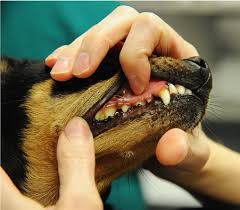
progresses your pet will begin to tire easily. Their gums will also lose the natural pink color and begin to look white. A blood transfusion may be needed once the anemia becomes severe. Your veterinarian can perform a simple blood test to discover the severity of your pets anemia and treat it appropriately.
Furthermore, small pets, puppies, kittens and older pets are more susceptible to becoming anemic from flea bites.
Tapeworm
Just knowing that worms are crawling around in my pets intestines makes me cringe. Tapeworms are small intestinal worms that are made up of many segments. Each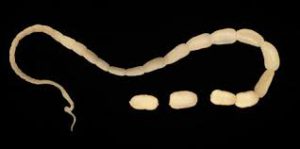 segment is approximately ¼inch long. Tapeworms live in the small intestine attaching themselves to the walls using hook-like mouthparts. As the tapeworms mature and grow they will begin to shed segments. As a result, the segments will appear in your pet’s stool looking like small pieces of rice.
segment is approximately ¼inch long. Tapeworms live in the small intestine attaching themselves to the walls using hook-like mouthparts. As the tapeworms mature and grow they will begin to shed segments. As a result, the segments will appear in your pet’s stool looking like small pieces of rice.
So how does your pet get this worm? Tapeworm eggs are swallowed by the flea larval and continue to develop as the flea matures. When your pet is licking and chewing on himself/herself they digest the infected flea larvae. Once inside the small intestine, the tapeworms will begin to grow by feeding off of the food your pet has digested.
Tapeworms are not considered highly harmful to your pet but they can cause your pet to lose weight and energy. A tapeworm infestation in young animals is much more serious. It can lead to slow growth, anemia, and intestinal blockage.
You may also notice that your pet is scooting its butt along the ground. They do this to relieve the irritation the tapeworm is causing to their anal area.
Treatment for tapeworm is relatively simple. Your veterinarian will give your pet an injection or pills that will dissolve the tapeworms. The drug given is safe and known to have no side effects.
Flea Allergy Dermatitis
This is the most common type of dermatitis that animals get. Every time a flea bites your pet their saliva is injected into your pet’s skin. Many animals are allergic to the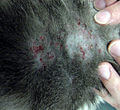 flea’s saliva. This causes great discomfort making your pet constantly scratch, lick, and chew his/her skin. You will begin to notice hair loss, lesions on the lower back, tail, inner thighs, and belly. Cats tend to get more lesions around the neck and head. If left untreated the lesions will become a secondary bacterial infection and yeast infection.
flea’s saliva. This causes great discomfort making your pet constantly scratch, lick, and chew his/her skin. You will begin to notice hair loss, lesions on the lower back, tail, inner thighs, and belly. Cats tend to get more lesions around the neck and head. If left untreated the lesions will become a secondary bacterial infection and yeast infection.
Your veterinarian will subscribe antibiotics to heal the lesions and may recommend a pet shampoo that is an antibacterial and antifungal formula.
Worn Down Teeth
This is known as Dental Attrition which is the wearing down of teeth. A certain amount of attrition is normal in pets as they age. The front teeth (incisors) are most affected when your pet chews on its skin. In normal circumstances, teeth repair themselves as they wear down. Unfortunately, constant chewing from fleas and allergies does not give the teeth time to repair themselves. These teeth will end up with exposed pulp canals causing infections and pain to your pet.
As a result, your veterinarian will need to perform an orthodontic assessment to find the severity of your pets dental attrition.
Flea control is the best way to avoid all these problems for your pet.
How to Control the Fleas on your Pet
First look for signs of fleas on your pet. Start by spreading your pet’s hair with your fingers, if you see small black specks this indicates that your pet has fleas. Those black specks are flea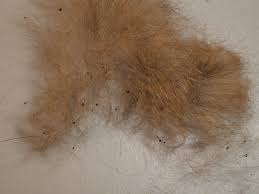 droppings. You may not see the fleas at first because they run and hide as you look through your pet’s hair. Now that you know the life cycle of the flea you can understand that it will take some time to completely eliminate fleas in your home, yard and on your pet. The most important thing to do first is to eliminate them from your pet. There are many different approaches you can take to do this. You will need to take the type of climate you live in into considerations when choosing what flea control method to use.
droppings. You may not see the fleas at first because they run and hide as you look through your pet’s hair. Now that you know the life cycle of the flea you can understand that it will take some time to completely eliminate fleas in your home, yard and on your pet. The most important thing to do first is to eliminate them from your pet. There are many different approaches you can take to do this. You will need to take the type of climate you live in into considerations when choosing what flea control method to use.
For example: If you live in a climate that has temperatures over 70 degrees with mild humidity for only a few weeks out of the year you will be able to eliminate fleas in a milder way. All natural flea repellents and other natural remedies will work.
If you live in a climate that stays over 70 degrees with high humidity for most of the year you will need to be more aggressive. Most of the natural flea repellents just won’t do the job. Applying a topical flea control to your pet may be your only option.
Bath your pet to kill the living adult fleas and eggs. Do not panic if you start to see blood like water running off your pet as you wet him/her down. This is caused by the flea droppings getting wet. Flea droppings consist of blood that they sucked out of your pet. Hense, that’s why you will see red water.
All Natural Flea Repellents
- Brewers Yeast
- Lemon or Orange Spray
- Lemongrass
- Coconut Oil
- Vinegar
- Cedarwood
- Cloves
- Eucalyptus
- Natural Essential Oils
- Flea & Tick Collar made with Natural Essential Oils
Furthermore, many Certified Organic pet shampoos contain natural ingredients for flea control.
More Aggressive Flea Repellents
- Flea shampoos and dips
- Flea Sprays
- Topical Flea Treatment
- Flea Collars
- Chewables to repel fleas
- Flea Powders
Personally, I am not a fan of dips, flea collars, and flea powders. I live in Florida and we have very few days when the temperature goes under 70 degrees. It is also humid here year round. I have tried several flea control methods and have come to the conclusion that Topical Flea Treatments work the best.
They not only keep the fleas off your pet they also repel fleas longer than any other type of flea control. Always follow the directions on the label and do not apply a topical flea treatment for at least 12 hours after you have bathed your pet. Being topicals are absorbed by the oils of the skin this will give your pet’s skin enough time to build up its natural oils that shampooing may have removed. This will vary with the type of pet shampoo you are using. Another reason why I always recommend using Certified Organic pet shampoos.
Your money spent on flea control outweighs the money you will have to spend at your veterinarian clinic if a flea infestation is left untreated. No matter which method you choose to try the most important thing is to get and keep fleas off of your pet.
Ways to Control Fleas in Your Home
Once you have treated your pet you will need to thoroughly clean your home to remove adult fleas, flea eggs, larvae, and pupae. Being 95% of the flea population lives in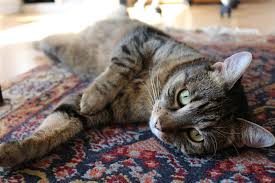 your carpet and fabrics these areas will need to be treated first. The adult fleas can easily be killed using rug shampoos, sprays or foggers. As an alternative to pesticides, you can sprinkle finely grounded table salt on your carpet and upholstery. The salt will dehydrate and dry out the bodies of the adult fleas.
your carpet and fabrics these areas will need to be treated first. The adult fleas can easily be killed using rug shampoos, sprays or foggers. As an alternative to pesticides, you can sprinkle finely grounded table salt on your carpet and upholstery. The salt will dehydrate and dry out the bodies of the adult fleas.
In addition, you will need to wash your pet’s bedding and toys in hot water to remove flea eggs, larvae, and pupae. Daily vacuuming is also recommended for several weeks. When fleas are in the pupae stage they are harder to remove because the cocoons are sticky. You can encourage them to hatch by using a humidifier, once hatched they will be easier to kill.
These steps will need to be repeated until you have removed every stage of the fleas life cycle from your home.
Controlling Fleas in the Yard
This is going to be more of a challenge, so know the facts now. You are never going to totally eliminate fleas in your yard. Keeping them to a minimum is going to be 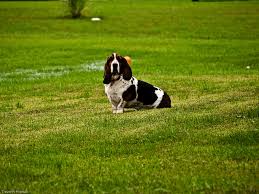 your goal. The reason I say this is because you can not control other flea carrying animals from entering your yard. These include squirrels, mice, rats, opossum, raccoons or any other wild animal that lives in your part of the world.
your goal. The reason I say this is because you can not control other flea carrying animals from entering your yard. These include squirrels, mice, rats, opossum, raccoons or any other wild animal that lives in your part of the world.
Once again you have the choice of using pesticides or going all natural. No matter which method you decide to use you will need to remove all toys, blankets, and food bowls before you begin. Start treating the area your pet frequents most then move on to the surrounding areas. Furthermore, remove the things that fleas like to breed in like piles of leaves, tall grass, and stacks of wood.
Natural treatments for your yard.
- Cedar wood chips
- Flood areas of infestation with water
- Nematodes spray
- Plant Pennyroyals in your yard
- Hire a professional pest control company that offers natural pest control
Pesticide treatments for your yard.
- Hose sprayer pesticides
- Tank pump pesticides
- Hire a professional pest control company
Safety should be your main priority if you choose to use pesticides. You will need to keep your pet/pets indoors until the pesticide is fully dry. If you decide to treat the yard yourself make sure to follow all the instructions on the label and wear protective clothing. Wearing a dust mask is also recommended.
Conclusion
I will sum this up simply, it doesn’t matter what method you choose to eliminate fleas as long as you are doing all you can to help protect your pet. After all, that is what matters most. Keeping your pet happy and healthy will require some work on your part. Educating yourself on pet care and following through with the things you learn will make you a better pet owner. Remember, flea control isn’t easy and will take time.
I am glad you took the time to read this article, if you have any questions please leave me a comment.
Happy pet grooming,

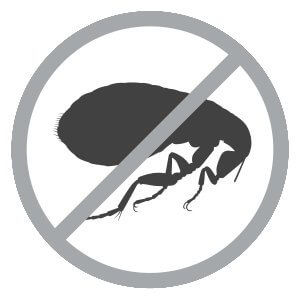
Cathy, this is such an important article for every dog and cat owner. Your explanation of how this whole thing works gives me a new outlook on fleas. We’ve lived in all climates from Louisiana to Arizona and finally Colorado. I always thought flea collars work everywhere. Foolish me. I also never knew the correlation between fleas and tapeworms. Time to look at all this differently starting today. Thanks for the good info. Warren
Hi Warren,
I agree that every pet owner should learn more about flea control. I’m happy to see that my article helped you to understand better. Thank you for the visit! 🙂
Thank you for a great informative post, Cathy. My knowledge of fleas was limited, but after reading your post I have a much better understanding about this pesky little pests.
Most interesting is the flea’s life cycle. By understanding this I know now how to treat the fleas on my dogs and how often.
I never really thought about treating my home and surrounding areas as well.
Should I first treat my dogs or my home and surrounding areas? What will be better? I know this will be a process and will take a week or two.
Thanks
-Rika
Hi Rika,
Thank you for visiting my site. I am glad you found this information to be helpful. The most important thing to do first is to rid your dog of fleas. Then treat the house and yard.